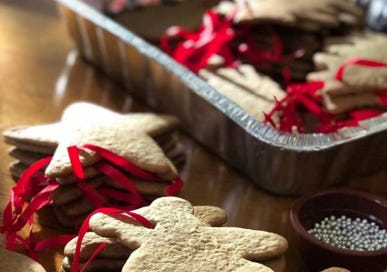Impossibly, December is here.
In this most unusual of years, the season marches on, heralding Christmas to come, and joy to be had, if we look hard enough.
Where better to look than in the kitchen? If you’ve discovered me on Instagram, you’ll know that I’ve been writing about cookbooks old and new as we count down the days to December 25.
It’s been so much fun to write longform on a bite-sized platform that I’ve decided to give myself a more permanent home here. At Delicious Bits, I’ll be sharing some of the recipes I feature on Instagram, as well as ruminating about food, travel, and anything else that catches my fancy.
To kick off the fun, here’s my recipe for my gingerbread cookies. Usually when this time of year rolls around, I find myself elbow deep in flour and spices, baking upwards of 300 of these beauties to give to dear family and friends at our annual Open House that celebrates the season.
So, where did gingerbread originate? According to Wikipedia, gingerbread was brought to France via Pompeii in 992 by the Armenian monk Gregory of Nicopolis. The recipe later spread to Sweden and to the nether regions of Europe, every country adding a twist to make it their own. The constant is the spicy heat from ginger and the abundance of spices in general, reflecting the tendency to use the most rare and coveted ingredients for the Christmas feast.
Gingerbread Cut-out Cookies
This recipe originally appeared in a local magazine. Over the years, I’ve changed the quantities and added new spices until I think they’re just about perfect. The yield is entirely dependant on the size of the cookie cutters used. Naturally, the smaller the cutter the greater the yield, but you are also limiting your ability to later personalise the cookies.
Ingredients
2 teaspoons baking soda
1 teaspoon salt
2 tablespoons powdered ginger
4 teaspoons cinnamon
1 teaspoons ground cloves
6 cups all purpose flour
1 cup vegetable shortening
1¾ cups brown sugar
1¼ cups white sugar
2 tablespoons dark molasses
3 large eggs, room temperature
½ cup milk
1. Preheat oven to 350°F.
2. Sift together the baking soda, salt, ginger, cinnamon, cloves and flour. Set aside.
3. In a stand mixer, cream together the shortening, the two sugars and molasses until light and fluffy, at least 5 minutes. Add the eggs slowly - one at a time – stirring on low until fully creamy before adding the next egg.
4. Add a little of the flour mixture to the creamed ingredients, incorporating fully before adding more. When the dough begins to stiffen, begin alternating flour mixture with milk, until both are incorporated. Mix until a dough is formed. Cover the dough and refrigerate for at least one hour.
5. Roll out the dough on a floured surface, about a ¼ inch thick (tip: roll out directly onto Silpat mats to avoid handling, or waxed paper for easier transfer to your baking sheet). Cut out gingerbread with cookie cutters. If you intend to use the cookies as ornaments, form a hole at the top of the cookie using a straw or chopstick, about a ¼ inch from the top.
6. Bake cookies until golden brown, about 10-12 minutes. Thy may be slightly soft when you take them out of the oven; they will firm up as they cool. Cool on racks and store until ready to decorate.
Five Tips for Baking Gingerbread Cookies
1. Start early. Gingerbread is hardy. If well cooled and stored in an airtight container, the cookies can be baked a couple of weeks in advance.
2. Sift dry ingredients ahead of time. If you`re making lots of cookies, sift the dry ingredients for each batch ahead of time and store in Ziplock bags. It`s an extra step done and makes the work go much more quickly.
3. Make the dough and prepare the cookies sheets in batches too. Because the dough has to rest for at least an hour, I spend one evening making the dough and store it in the fridge and then do a massive baking the next night. Instead of popping every tray in the oven as they're full, I do five full sheets at a time, eliminating the need to constantly open the oven door.
4. Use chopsticks to form the holes...both before and after baking. The holes tend to lose their shape during baking; a quick turn in each cookie ensures you`ll be able to thread ribbon through much more easily.
5. Buy extra oven racks. I only really bake en masse once a year, but even so that one time made it worth it for me to buy three extra oven racks from my oven manufacturer for mass baking. Plus, I`m able to use those extra racks for reheating hors d'oeuvres while entertaining.
With the world in lockdown mode, that Open House will have to wait. But cookie baking and Christmas go hand in hand. So get out your flour, get cracking some eggs and buy a cookie cutter from your favourite local shop. As Mary Poppins says, a little sugar makes the medicine go down, in the most delightful way.







